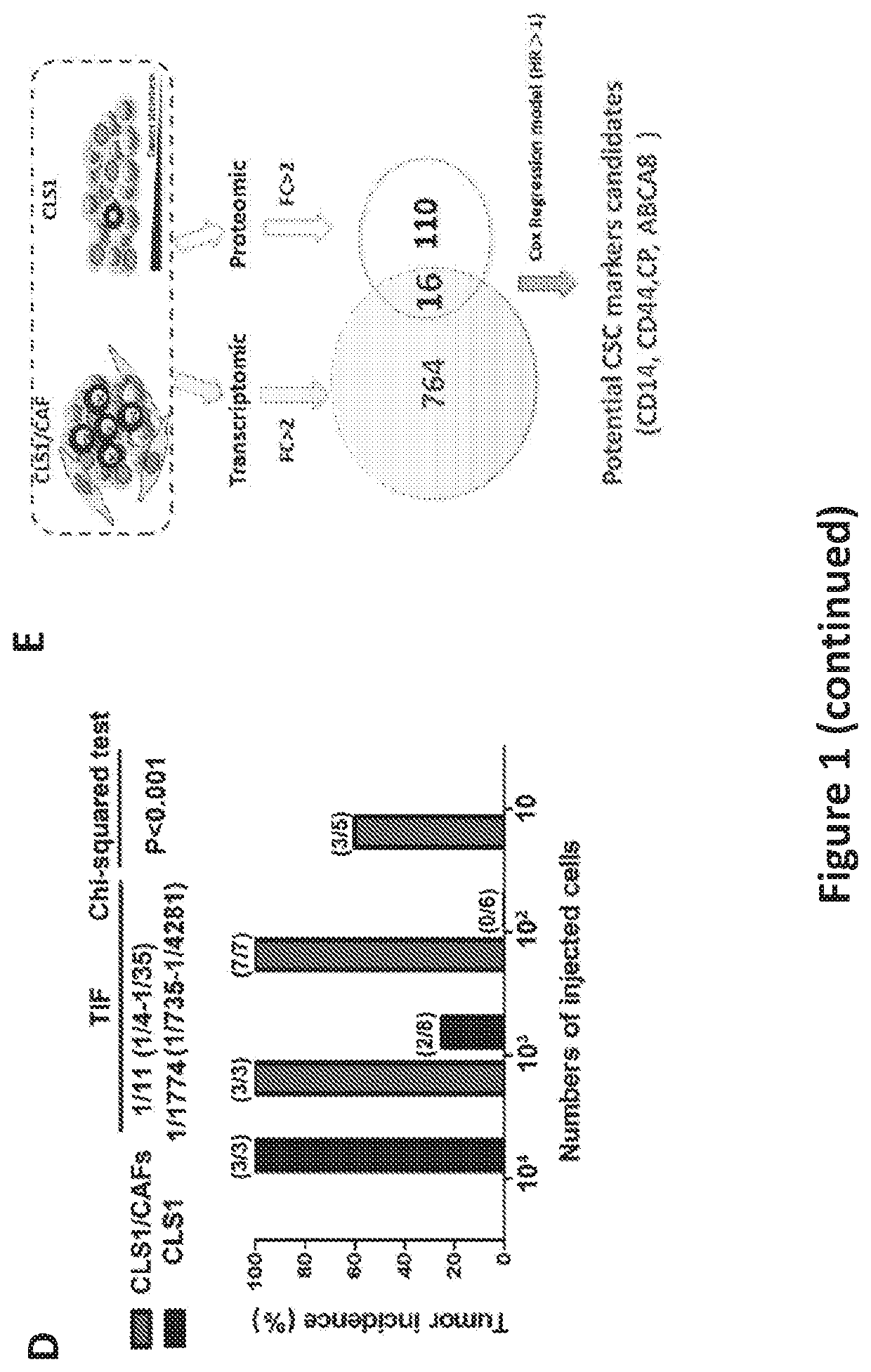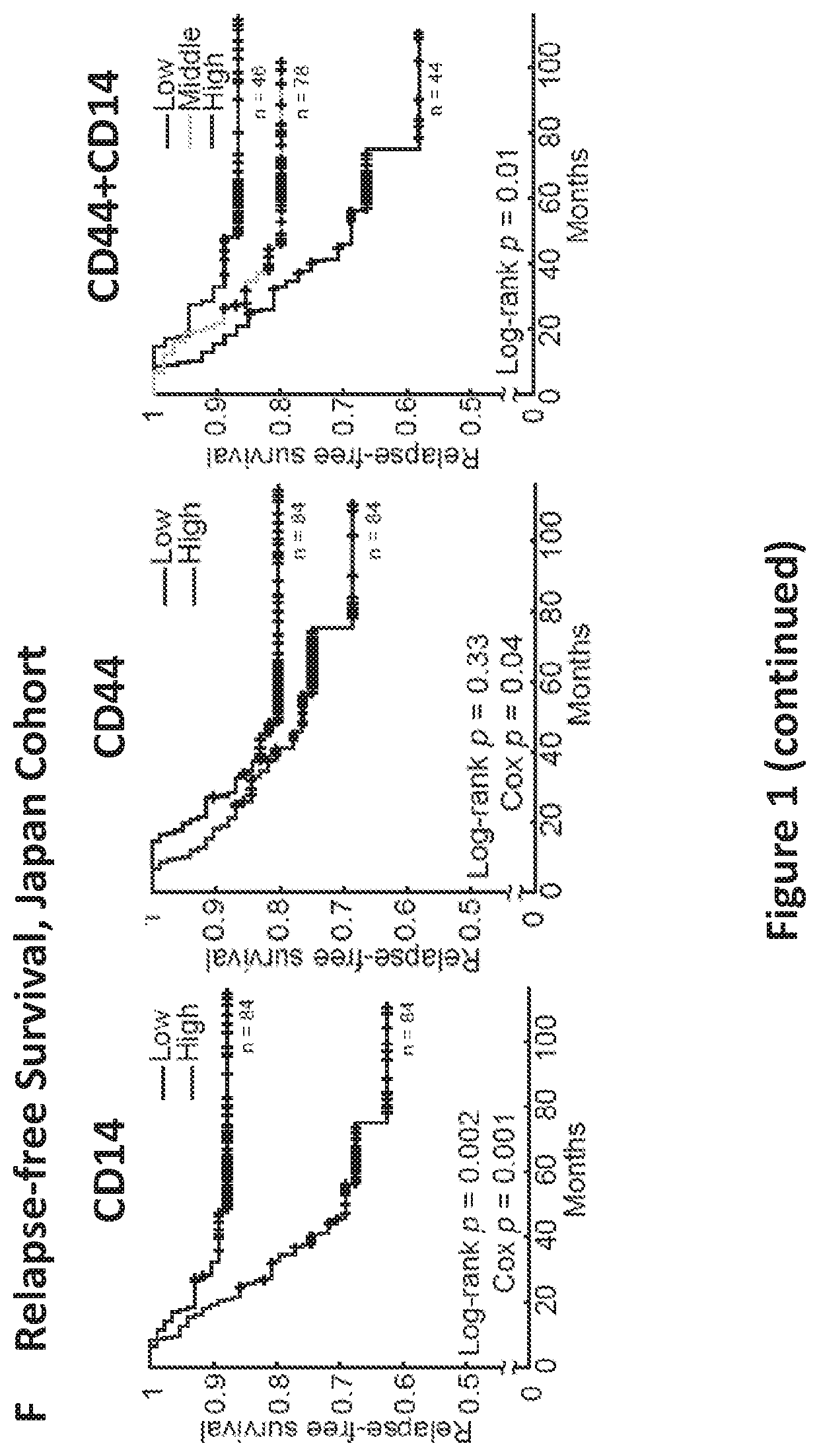Biomarkers for lung cancer stem cells
a technology of stem cells and biomarkers, applied in the field of lung cancer stem cells, can solve the problems of drug resistance and relapse of most patients
- Summary
- Abstract
- Description
- Claims
- Application Information
AI Technical Summary
Benefits of technology
Problems solved by technology
Method used
Image
Examples
example s
Example 1
Identification of Proteins Differentially Present on Lung Cancer Stem Cells (CSCs) as Compared to Primary Lung Cancer Cells
Materials and Methods
Lung Cancer Cell Lines
[0100]The human NSCLC cell lines NCI-A549, EKVX, PC9 and HCC827 were obtained from the National Cancer Institute (National Institutes of Health, Bethesda, Md., USA) or the American Type Culture Collection (ATCC, Manassas, Va., USA). Human lung cancer cell lines (CLS1, CL100, CL141 and CL152) were established using primary cultures from lung cancer patients. The cells were cultured in RPMI 1640 medium supplemented with 10% FBS at 37° C. under a humidified atmosphere consisting of 20% O2 and 5% CO2.
Co-Culture System for Culturing Lung CSCs and CAFs
[0101]Human lung CSCs and CAFs were established from freshly resected lung tumor tissues from lung cancer patients. Tumors and paired normal tissues were harvested within 30 min after resection to isolate primary lung CSC, CAF and NF cultures using a modified protocol. ...
example 2
CD14 and CD44 Correlated with Poor Prognosis
Materials and Methods
Patients and Tumor Specimens
[0116]Lung tumor tissue specimens were obtained from patients (N=80) with histologically confirmed NSCLC who had undergone complete surgical resections at the National Taiwan University Hospital (Taipei, Taiwan) between Dec. 28, 1995 and Dec. 26, 2005. This investigation was approved by the Institutional Review Board of the National Taiwan University Hospital (201103028RC). The enrolled patients were classified as stage I, and they had not been previously treated with neoadjuvant chemotherapy or irradiation therapy. All patients provided informed consent. All specimens were formalin-fixed, sectioned, stained with H&E and examined through microscopy. Pathological staging was performed by Dr. Yih-Leong Chang according to the international staging system for lung cancer.
Immunohistochemistry Analysis Tumor Samples from Lung Cancer Patients.
[0117]The immunohistochemistry analysis of tumor samples...
example 3
Co-Culture with CAFs Led to Enrichment of CD44+CD14+ Lung Cancer Stem Cells
Materials and Methods
[0122]Cells were fixed with 4% paraformaldehyde in phosphate buffered saline (PBS) at room temperature. A standard immunofluorescence protocol was followed. Blocking and hybridization were performed in 3% (wt / vol) bovine serum albumin (BSA) in PBS. Monoclonal antibodies (mAbs) targeting Nanog (ReproCELL; 1:300), CD90 FITC-conjugated (5E10; BD Pharmingen;1:100), CD44 FITC-conjugated (G44-26; BD Pharmingen;1:10), and CD14 PE-conjugated (HCD14; Biolegend; 1:20) antibodies, were used. The stained cells were examined using an Axiovert 200 microscope (Carl Zeiss, Göttingen, Germany), and a confocal laser scanning microscope (C1si, Nikon, Japan) with MetaXpress® (Molecular Devices).
Western Blot Analyses
[0123]The detailed procedures were performed according to standard procedures. The primary antibodies for Nanog (D73G4; 1:1000) were purchased from Cell Signaling Tech...
PUM
| Property | Measurement | Unit |
|---|---|---|
| temperature | aaaaa | aaaaa |
| density | aaaaa | aaaaa |
| thick | aaaaa | aaaaa |
Abstract
Description
Claims
Application Information
 Login to View More
Login to View More - R&D
- Intellectual Property
- Life Sciences
- Materials
- Tech Scout
- Unparalleled Data Quality
- Higher Quality Content
- 60% Fewer Hallucinations
Browse by: Latest US Patents, China's latest patents, Technical Efficacy Thesaurus, Application Domain, Technology Topic, Popular Technical Reports.
© 2025 PatSnap. All rights reserved.Legal|Privacy policy|Modern Slavery Act Transparency Statement|Sitemap|About US| Contact US: help@patsnap.com



